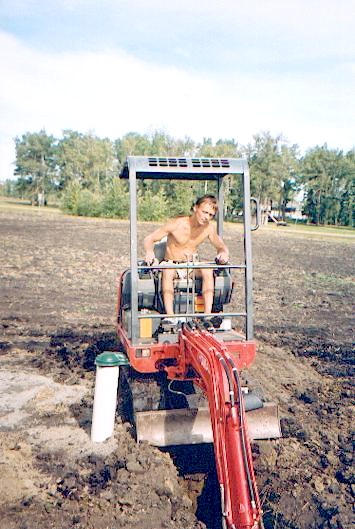
Excavating
Little Thomas

T15 was definitely not meant for digging foundations. I looked at its specification and found that a digging depth was 2.3m, which was more than enough for digging below the frost level, which in Alberta was 1.2m. The problem was the bucket capacity, 0.04 cubic meters.
I didn't want to have a basement in my house because it had plenty of space without it (2000 sq. ft). So my plan was to dig trenches about a meter wide for the foundation walls slightly deeper than the frost penetration, roughly 1.2 meter deep and have 60 to 80 cm crawl space everywhere else except the garage. Given 70 meter house perimeter and 100 square meters of floor space, one could easily calculate the amount of dirt to dig out. The figure would be between 144 and 164 cubic meters that translated to 3600 to 4100 full buckets. One weekend was clearly not enough for little Thomas.

It was very efficient for digging trenches though. I dug the entire septic field, total of four trenches, 50 meter long each plus one to interconnect them and another one to the septic tank. I also dug a deep trench to a water well and another one to an electric pole at the corner of the lot near the road.
I had to excavate a hole for a septic tank too. That wasn't easy as it had to be quite deep. Also, the space under the sun room was supposed to be as deep as the footing because later I wanted to build a wine cellar there. A sump pit was to be installed there as well.
Excavating took three weekends instead of one. But that was only the beginning of real digging. According to the Building Code and common sense too, footing should be rested on the undisturbed leveled ground. Therefore, I had to be very careful when excavating not to dig too deep. Of course, I had stayed on a safe side and spent another month leveling the ground with a shovel.
All in all, it was an interesting experience as I had never run an backhoe in my life. I also had a chance to operate a slightly bigger model one weekend but I don't have a picture of it. I felt the difference in performance right away. My advice to anyone who has never run a digger, get a big one. It will cost you more per day but a job can be done in no time.
